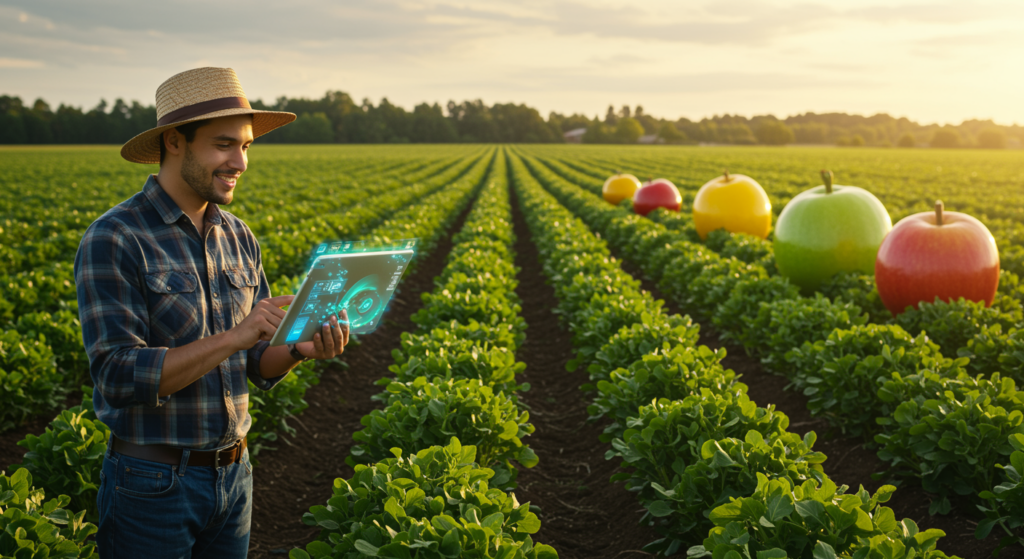
AI in Farming: Boosting Food Production with Fewer Resources
Transforming Agriculture Through AI: A New Era of Efficiency
AI in farming is reshaping how we grow food, making it possible to feed a growing world while using less water, land, and chemicals. As populations expand and resources dwindle, these smart technologies help farmers optimize every step, from planting to harvest. Imagine turning vast fields into high-tech operations that predict problems before they arise—it’s not science fiction anymore.
Today’s farmers deal with erratic weather, shrinking farmland, and the pressure to produce more sustainably. AI steps in as a game-changer, using data to cut waste and boost yields, all while easing the strain on our planet. Have you ever wondered how a simple app could help a farmer save thousands of gallons of water? That’s the power of AI in farming at work.
Predictive Analytics: The Future of AI in Farming
One standout feature of AI in farming is predictive analytics, which crunches data to forecast everything from storms to pest outbreaks. By examining past trends and live updates, these tools give farmers a heads-up, letting them act fast and protect their crops. This approach isn’t just about reacting—it’s about staying ahead in an unpredictable world.
A study from the International Journal of Information Management shows that AI-driven predictive analytics can lift crop yields by up to 25%. That’s huge for farmers facing tight margins, as it means better planning for planting, watering, and even market sales. For instance, if a farmer in the Midwest uses this tech to spot an early frost, they could adjust their schedule and avoid major losses—what a relief that would be!
Key Benefits of AI in Farming’s Predictive Tools
Let’s break it down: AI helps with early disease detection, precise weather predictions, and even anticipating market needs.
- Spot crop diseases before they show up visibly, saving time and resources.
- Pinpoint the best times for planting or harvesting based on accurate forecasts.
- Predict demand to choose the right crops and quantities.
- Determine ideal moments for fertilizing or irrigating to maximize efficiency.
With climate change throwing curveballs, AI in farming provides the insights needed to adapt quickly. It’s like having a crystal ball that helps farmers in regions like California thrive despite droughts or floods.
Smart Crop Monitoring with AI in Farming
AI in farming excels in crop monitoring, using cameras on drones and satellites to watch over fields in real time. These systems spot issues like nutrient shortages or pests early, when a quick fix can make all the difference. It’s about turning data into actionable steps that keep crops healthy and productive.
Tools like AI-powered sensors gather info from the air and ground, analyzing it to reveal hidden problems. For example, a drone might detect a subtle color change in leaves, signaling a deficiency that humans could miss. If you’re a farmer, this means less guesswork and more precise care for your land.
Real-Time Tech in AI-Driven Farming
Drones are a favorite in AI in farming, offering bird’s-eye views to check crop health and irrigation. When paired with AI, they enable targeted treatments, like applying just the right amount of pesticide where it’s needed. This not only boosts yields but also cuts down on environmental harm—think of it as farming smarter, not harder.
These innovations catch problems invisible to the naked eye, preventing small issues from becoming disasters. A quick tip: Start with a basic drone setup if you’re new to this; it could transform how you manage your fields and reduce chemical use significantly.
Automating Farms with AI Technology
AI in farming is automating tedious tasks, from seeding to weeding, through robots that work around the clock. This shift reduces labor costs and speeds up operations, making farms more efficient than ever. It’s a lifeline for areas struggling with worker shortages, letting technology handle the heavy lifting.
Research from the Food and Agriculture Organisation indicates that robotics can slash labor expenses by up to 90%. Companies like John Deere are leading the way with autonomous tractors that plant and harvest without a driver. Picture this: Your farm running smoothly even when you’re not there—it’s a reality with AI in farming.
Autonomous Tools in Modern AI Farming
These machines, from self-driving tractors to smart harvesters, perform jobs with pinpoint accuracy. They work longer hours than any human team, increasing output while minimizing errors. If you’re considering upgrades, focus on models that integrate easily with your existing setup for the best results.
AI-driven robots can gently pick fruits without bruising them, ensuring top-quality produce. This level of precision not only improves profits but also supports sustainable practices by reducing waste.
Optimizing Resources via AI in Farming
At its core, AI in farming is about smart resource management, ensuring every drop of water and nutrient is used wisely. By analyzing data in real time, it helps farmers cut back on excess without sacrificing growth. This is key for sustainable practices in water-scarce areas.
AI-Enhanced Irrigation Systems
Water conservation is a big win with AI in farming’s irrigation tech, which monitors soil moisture and adjusts flows automatically. It factors in weather, soil type, and plant needs to avoid overwatering. In places like arid regions, this could mean saving thousands of liters per acre—imagine the impact on local water supplies.
These systems create customized schedules that keep crops thriving. A practical step: Install soil sensors first; they’ll provide immediate data to guide your irrigation and lower costs over time.
Monitoring Soil Health with AI
AI tools assess soil quality, detecting imbalances in nutrients or pH levels before they affect yields. This allows for targeted fixes, like applying fertilizer only where necessary. It’s a game-changer for maintaining fertile land without overloading it with chemicals.
Detailed soil maps from AI help with variable-rate applications, cutting waste and boosting efficiency. What if you could turn poor soil patches into productive ones effortlessly? That’s the potential here.
Streamlining the Supply Chain with AI in Farming
AI in farming extends to the supply chain, predicting demand and reducing losses from farm to table. By analyzing trends, it optimizes inventory and transportation, minimizing waste. This holistic approach ensures fresh produce reaches consumers efficiently.
Minimizing Post-Harvest Waste
A lot of food spoils after harvest, but AI systems use smart storage and monitoring to extend shelf life. They adjust conditions like temperature based on crop needs, while sorting tech identifies quality issues quickly. For farmers, this means more reliable income and less discarded produce.
Actionable advice: Use AI apps for inventory tracking; they can help you forecast sales and adjust operations accordingly. Have you tried integrating such tools into your business yet?
Fueling Innovation in AI for Farming
AI in farming is driving research and collaboration, leading to new solutions for global challenges. The FAO predicts it could boost production by 20-30% by 2050, helping meet rising food needs. This innovation cycle benefits everyone from smallholders to large operations.
Building Collaborative Networks
Data-sharing platforms let farmers and experts exchange insights, speeding up improvements. It’s about creating adaptable strategies for different climates and soils. A quick example: One farmer’s success with drought-resistant techniques could inspire others worldwide.
To get involved, join local AI farming networks—they offer training and resources to implement these changes effectively.
Promoting Sustainability Through AI in Farming
AI supports eco-friendly practices like reduced tillage and better nutrient management, making farms more resilient. It provides the data needed to balance productivity with environmental care. In essence, it’s about farming for the future.
AI’s Role in Carbon Management
By tracking soil carbon, AI helps farmers participate in credit programs, turning green practices into extra revenue. This reduces emissions and enhances soil health. It’s a win-win: Better for the planet and your wallet.
Start small by monitoring your farm’s carbon footprint; AI tools make it straightforward and impactful.
The Road Ahead for AI in Farming
As AI evolves, its role in farming will grow, with advancements like blockchain for tracking and more advanced robots. The key is making these tools accessible to all farmers, big or small. This inclusivity is vital for global food security.
Getting Started with AI Implementation
If you’re ready to dive in, begin with simple applications like basic monitoring systems. They offer quick wins and pave the way for larger setups. Educational programs are also ramping up to teach these skills, ensuring the next generation is prepared.
Remember, AI in farming isn’t just about tech—it’s about building a sustainable legacy.
Wrapping Up: A Smarter Path Forward
AI in farming is revolutionizing the industry, turning resource challenges into opportunities for growth. By producing more with less, it addresses key issues like food scarcity and environmental impact. What excites you most about these changes?
We’d love to hear your thoughts—share your experiences in the comments, explore more on our site, or connect with fellow farmers. Let’s keep the conversation going!
References
Here are the sources used in this article:
- Intellias. “Artificial Intelligence in Agriculture.” https://intellias.com/artificial-intelligence-in-agriculture/
- Basic.ai. “7 Applications of AI in Agriculture.” https://www.basic.ai/blog-post/7-applications-of-ai-in-agriculture
- Datategy. “AI in Agriculture: Innovations for Sustainable Food Production.” https://www.datategy.net/2024/03/26/ai-in-agriculture-innovations-for-sustainable-food-production/
- FFA. “How AI Can Impact Agriculture.” https://www.ffa.org/technology/how-ai-can-impact-agriculture/
- Appinventiv. “AI in Food Industry.” https://appinventiv.com/blog/ai-in-food-industry/
- HashStudioz. “AI in Agriculture: Reducing Waste and Improving Efficiency.” https://www.hashstudioz.com/blog/ai-in-agriculture-reducing-waste-and-improving-efficiency/
- Writesonic. “How to Write Blog Post.” https://writesonic.com/blog/how-to-write-blog-post/
- Charles Aris. “AI on the Farm.” https://charlesaris.com/thought-leadership/ai-on-the-farm/
AI in farming, precision agriculture, agricultural automation, sustainable farming, crop monitoring, AI-driven irrigation, predictive analytics in agriculture, smart farming technologies, resource-efficient agriculture, data analytics in farming







